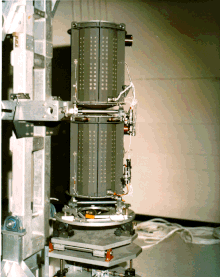사용자:Rlagmlrn4u/작업장/보이저

The Voyager program consists of a pair of unmanned scientific probes, Voyager 1 and Voyager 2. They were launched in 1977 to take advantage of a favorable planetary alignment of the late 1970s. Although they were officially designated to study just Jupiter and Saturn, the two probes were able to continue their mission into the outer solar system. They have since continued out and will one day exit the solar system. These probes were built at JPL and were funded by NASA.
Both missions have gathered large amounts of data about the gas giants of the solar system, of which little was previously known. In addition, the spacecraft trajectories have been used to place limits on the existence of a hypothetical post-Plutonian Planet X.
History[편집]
The Voyager probes were originally conceived as part of the Mariner program, and designated Mariner 11 and Mariner 12, respectively. They were then moved into a separate program named Mariner Jupiter-Saturn, later retitled Voyager because it was more appealing and romantic. Voyager is a scaled-back version of the Grand Tour program of the late 1960s and early 1970s. The Grand Tour's plan was to send a pair of probes to fly by all the outer planets; it was scaled back because of budget cuts. However, in the end, Voyager fulfilled all the Grand Tour flyby objectives except for Pluto, which at the time was considered a planet by the IAU.

In the 1990s, Voyager 1 overtook the slower travelling Pioneer 10 to become the most distant human made artifact in space. It will keep that record for at least several decades; even the fast (at launch) New Horizons probe will not catch up with it since its final speed will be less than Voyager 1's. Voyager 1 and Pioneer 10 are also the most widely-separated man made objects in the Universe because they are travelling in roughly opposite directions from the sun.
Periodic contact has been maintained with both probes to monitor conditions in the outer expanses of the solar system. The crafts' radioactive power sources are still producing electrical energy, fuelling hopes of locating the solar system's heliopause. In late 2003, Voyager 1 began sending data that seemed to indicate it had crossed the termination shock, but interpretations of this data are in dispute. It is now believed that the termination shock was crossed in December 2004, with the heliopause an unknown distance ahead.
Due to budget cuts prompted by President George W. Bush's Vision for Space Exploration, it was rumored that the probes were to be deactivated and abandoned[1] as early as October 2005, before they would have observed the heliopause. However, the program continues to be funded into 2007.

As of April 4, 2007, Voyager 1 is over 15.18 terameters (15.18×1012 meters, or 15.18×109 km, 101.4 AU, or 9.4 billion miles) from the Sun, and has thus entered the heliosheath, the termination shock region between the solar system and interstellar space, a vast area where the Sun's influence gives way to the other bodies in the galaxy.
As of September 2006, Voyager 2 is at a distance of around 80.5 AU (approximately 12 terameters) from the Sun, deep in the scattered disc, and traveling outward at roughly 3.3 AU a year. It is more than twice the distance from the Sun as Pluto. On December 10, 2007, instruments on board Voyager 2 sent data back to Earth indicating that the Solar System is asymmetrical (i.e., bent). It has reached the termination shock, about 10 billion miles from where Voyager 1 first crossed.
Spacecraft design[편집]
The identical Voyager spacecraft are three-axis stabilized systems that use celestial or gyro referenced attitude control to maintain pointing of the high-gain antennas toward Earth. The prime mission science payload consisted of 10 instruments (11 investigations including radio science). Only five investigator teams are still supported, though data is collected for two additional instruments.[2] The Flight Data Subsystem (FDS) and a single eight-track digital tape recorder (DTR) provide the data handling functions. The FDS configures each instrument and controls instrument operations. It also collects engineering and science data and formats the data for transmission. The DTR is used to record high-rate Plasma Wave Subsystem (PWS) data. The data is played back every six months.
The Imaging Science Subsystem, made up of a wide angle and a narrow angle camera, is a modified version of the slow scan vidicon camera designs that were used in the earlier Mariner flights. The Imaging Science Subsystem consists of two television-type cameras, each with 8 filters in a commandable Filter Wheel mounted in front of the vidicons. One has a low resolution 200 mm wide-angle lens with an aperture of f/3 (Wide Angle Camera), while the other uses a higher resolution 1500 mm narrow-angle f/8.5 lens (Narrow Angle Camera).
Unlike the other onboard instruments, operation of the cameras is not autonomous, but is controlled by an imaging parameter table residing in one of the spacecraft computers, the Flight Data Subsystem (FDS).
The computer command subsystem (CCS) provides sequencing and control functions. The CCS contains fixed routines such as command decoding and fault detection and corrective routines, antenna pointing information, and spacecraft sequencing information. The Voyager spacecraft have three RCA 1802 CPUs running at 6.4 MHz. These CPUs sent to space were operating at full military specification temperatures (-55 to +125 °C).
The Attitude and Articulation Control Subsystem (AACS) controls the spacecraft orientation, maintains the pointing of the high-gain antenna towards Earth, controls attitude maneuvers, and positions the scan platform.
Uplink communications is via S band (16-bit/s command rate) while an X band transmitter provides downlink telemetry at 160 bit/s normally and 1.4 kbit/s for playback of high-rate plasma wave data. All data is transmitted from and received at the spacecraft via the 3.7-meter high-gain antenna.
Power[편집]

Electrical power is supplied by three radioisotope thermoelectric generators (RTGs). They are powered by plutonium-238 (distinct from the Pu-239 isotope used in nuclear weapons) and provided approximately 470 W at 30 volts DC when the spacecraft was launched. Plutonium-238 decays with a half-life of 87.74 years, [3] so RTGs using Pu-238 will lose a factor of of their power output per year. In 2006, 29 years after launch, such an RTG would produce only 470 W × 2-(29/87.74) ~= 373 W — or about 79.5% — of its initial power. However, the bi-metallic thermocouples that convert heat into electricity also degrade, so the actual power will be even lower. As of August 11 2006, the power generated by Voyager 1 and Voyager 2 had dropped to 290 W and 291 W respectively, about 60% of the power at launch. This is better than the pre-launch predictions based on a conservative thermocouple degradation model. As the electrical power decreases, spacecraft loads must be turned off, eliminating some spacecraft capabilities.
Powering down[편집]
As of the present date, the Voyager 2 and Voyager 1 scan platforms, including all of the platform instruments, have been powered down. The ultraviolet spectrometer (UVS)[4] on Voyager 1 was active until 2003, when it too was deactivated. Gyro operations will end in 2010 for Voyager 2 and 2011 for Voyager 1. Gyro operations are used to rotate the probe 360 degrees six times a year to measure the magnetic field of the spacecraft, which is then subtracted from the magnetometer science data.
The two Voyager spacecraft continue to operate, with some loss in subsystem redundancy, but retain the capability of returning scientific data from a full complement of VIM science instruments. Both spacecraft also have adequate electrical power and attitude control propellant to continue operating until around 2020, when the available electrical power will no longer support science instrument operation. At that time, science data return and spacecraft operations will cease. It is possible that one or both craft may have enough RTG energy to last until 2025, but there is only a small probability of this.[출처 필요]
Voyager Interstellar Mission[편집]
The Voyager primary mission was completed in 1989 with the close flyby of Neptune by the Voyager 2 spacecraft. The Voyager Interstellar Mission (VIM) is a mission extension which began when the two spacecraft had already been in flight for over 12 years.[5] The Heliophysics Division of the NASA Science Mission Directorate conducted a Heliophysics Senior Review in 2008. The panel found that the VIM, "is a mission that is absolutely imperative to continue" and that VIM "funding near the optimal level and increased DSN support is warranted."[6]
Voyager Golden Record[편집]
Voyager 1 and 2 both carry with them a golden record that contains pictures and sounds of Earth, along with symbolic directions for playing the record and data detailing the location of Earth. The record is intended as a combination time capsule and interstellar message to any civilization, alien or far-future human, that recovers either of the Voyager craft. The contents of this record were selected by a committee chaired by Carl Sagan.
Fiction and popular culture[편집]
The Voyager launches occurred just before the dawn of the media-savvy 1980s, and the program's discoveries during the primary phase of its mission, including striking never-before-seen close up color photos of the major planets, were regularly documented by both print and electronic media outlets. As a result, the Voyager program, especially at the high points of its mission, has seen significant public limelight. As a result, there are a number of references to the Voyager program or to the particular probes themselves within popular culture.
- Star Trek: The Motion Picture has as its premise an alien intelligence, V'ger, which turns out to be a fictional Voyager 6.
- Stephen Baxter's novel Titan (1997) describes what will happen to the Voyager probes billions of years in the future as the metal from which they are constructed gradually disintegrates.
- In L. Ron Hubbard's novel Battlefield Earth, aliens who stumble on Voyager and its golden contents proceed to find and conquer Earth.
- In the X-Files episode "Little Green Men" in Season 2, Special Agent Fox Mulder (David Duchovny) hears part of the golden record played back to him in an extraterrestrial transmission received at Arecibo Observatory.
- John Carpenter's 1984 movie Starman opens with the Voyager 1 probe being intercepted by an alien spacecraft, whose occupants play the golden record.
Notes and references[편집]
- ↑ “Voyager probes in funding crisis”. BBC. 2005년 3월 10일.
- ↑ -Nasa Website Voyager
- ↑ The Actinide Research Quarterly: Summer 1997
- ↑ “Ultraviolet Spectrometer”. 《Voyager: The Interstellar Mission》. NASA JPL. 2006년 6월 11일에 확인함.
- ↑ “Interstellar Mission”. NASA.
- ↑ “Senior Review 2008 of the Mission Operations and Data Analysis Program for the Heliophysics Operating Missions” (PDF). NASA. p. 7쪽.
|title=에 라인 피드 문자가 있음(위치 71) (도움말)
External links[편집]
See also[편집]
External links[편집]
- NASA Voyager website - Main source of information.
- Voyager Spacecraft Lifetime
- Space Exploration - Robotic Missions
- NASA Facts - Voyager Mission to the Outer Planets (PDF format)
- Spacecraft Escaping the Solar System - current positions and diagrams
- Voyager 1 and 2 atlas of six Saturnian satellites (PDF format) 1984
- Mission state (more often than not at least 3 months out of date)

